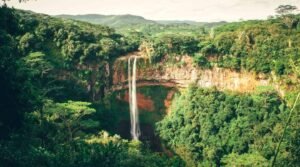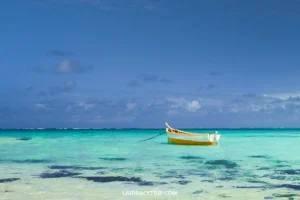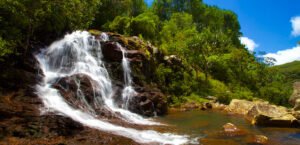


In the first moments after arrival, you sense that Mauritius is more than a resort—it’s a tapestry of contradictions: a small island with enormous diversity; a paradise that hides wild edges; a land of luxury and simplicity side by side. You might land in Port Louis under a sky powdered pink by sunset, then find yourself within hours in the silent green hush of a forest trail or standing on cliffs where ocean waves crash in thunder. That is the canvas on which the best places to visit in Mauritius are painted.
Setting the Stage: Mauritius in 2025
Before we step into each place, a few notes to orient your journey.
Mauritius lies in the southwest Indian Ocean, about 2,000 kilometers off the southeast African coast. Colonized by the Dutch, French, and British, and inhabited by people of Indian, African, Chinese, and European descent, it is today a multicultural society with Buddhism, Hinduism, Christianity, and local Creole culture woven together.
The island is geologically volcanic. Even though the volcanoes are extinct, their legacy persists in the undulating uplands, basalt cliffs, and fertile soils. Many of the best places to visit in Mauritius derive their character from that geologic energy—waterfalls cascading over basalt ridges, soils colored by minerals, cliffs shaped by ancient lava flows.
In 2025, Mauritius continues to evolve. Sustainability and conservation are rising priorities: marine parks like Blue Bay, forest reserves, and national parks receive attention. Infrastructure—roads, signage, visitor facilities—has improved, yet many spots remain refreshingly undeveloped. The island’s beauty is broadly known, but parts still feel like hidden gems.
When you travel, the island awakens not only your senses but your curiosity. Every beach, hill, temple, or garden holds stories—in ecology, in colonial history, in cultural fusion. As you walk these places, their colors and contrasts will shape memories of calm.
Let us now journey through the best places to visit in Mauritius, region by region, weaving narrative and insight.
Northern Mauritius: Lagoon Dreams & Cultural Corners
Trou-aux-Biches: White Sand, Quiet Shade, Snorkel Corners
Your Mauritius journey can begin in the north, and one of the first places to visit is Trou-aux-Biches, often heralded as one of the most beautiful beaches on the island. The best places to visit in Mauritius often include this stretch because of its gentle reef-protected lagoon, long white sands, and soothing shade from casuarina trees. Wikipedia
In the golden morning light, fishermen push outrigger canoes into the lagoon, children splash near the reef break, and colorful kites drift across a candy-blue sky. Under the water, coral gardens host parrotfish, sea urchins, and tiny angel fish. A snorkel or mask-and-snorkel set can reveal astonishing detail in just a few meters of depth.
Walking along the beach, you pass small cafés and boutique hotels. The pace is slow, calm. At sunset, the light softens coral and sky alike. You linger here, watching day become evening, immersed in calm.
Cap Malheureux and the Red Church
Not far to the north tip of the island lies Cap Malheureux and its iconic Red Church (Notre Dame Auxiliatrice). In many guidebooks, this chapel is among the best places to visit in Mauritius because of its photogenic contrast: the white walls and deep red roof stand out sharply against the blue sea behind them. LAIDBACK TRIP
The area is charming: fishermen mending nets, palms swaying, distant islands on the horizon. You might arrive mid-afternoon, linger while Church bells chime, and feel how simplicity draws attention. Even though the church is small, its visual resonance lingers in memory.
Grand Baie, Pereybere & the North Coast
From there, you might head eastward along the northern rim toward Grand Baie, the lively hub of the north. Though more commercial than some corners, it has become a key node in the best places to visit in Mauritius set, offering shopping, dining, boat excursions, and social energy.
Pereybere lies tucked nearby, quieter yet easy of access, with sheltered waters ideal for swimming. Grand Baie, with its cafés, boutiques, boat trips to nearby islets, and lively evening life, gives you contrast—a mix of calm daytime and spirited nightfall.
Pamplemousses / Sir Seewoosagur Botanical Garden
Moving inland just a little, the Sir Seewoosagur Botanical Garden, often simply called the Pamplemousses Garden, is one of the historic and botanical highlights of Mauritius. Many travel guides list it among the best places to visit in Mauritius because of its rich flora, giant water lilies (Victoria amazonica), and exotic palms. Enchanting Travels+1
Strolling the shaded pathways under royal palms, giant ferns, and flowering trees, you pause by ponds filled with lily pads so large they seem like floating islands. A sense of calm presides. The garden was established in the 18th century by colonial botanists and remains among the oldest in the southern hemisphere.
Inside, you’ll see spice trees, medicinal plants, and endemic species. Local guides are often available to point out history, plant usage, and conservation efforts.
Eastern Mauritius: Lagoon, Island Escapes & Hidden Temples
Île aux Cerfs: A Lagoon-Island Fantasy
One of the most celebrated among the best places to visit in Mauritius is Île aux Cerfs, a small private island perched in its own turquoise lagoon off the east coast. Tripadvisor+2Goway Travel+2
You typically depart from a harbor in Trou d’Eau Douce or a nearby jetty. The ride can be breezy, the sea sparkling with sun, and the landing feels like a dream. On the island itself, powdery white sand stretches widely, and shallow water laps your feet as you walk across channels between islets.
For many visitors, the lagoon sandbank stretch between Île aux Cerfs and Ilot Mangénie is the highlight: you can wade knee-deep through shallow channels, surrounded by coral flats and fishes. Nearby, the island supports a luxury hotel, golf course, and small cafés, but much of the island remains soft, inviting, and open to exploration.
Water sports abound: parasailing, kayaking, snorkeling, and boat tours all are available. In 2025, conservation efforts aim to regulate visitor numbers and protect reef life. A visit here is sensory—sun, water, color—and benign in tempo.
Belle Mare & East Coast Beaches
Back on the main island, Belle Mare is a stretch of east-coast coastline lauded for its long beaches, green vegetation, and emerald lagoon. In many “best of Mauritius” lists, it appears as a more upscale, quietly elegant beach alternative. Go2Africa+1
The beaches are wide, the sand soft, and the sea sometimes lively—swimming is possible in more sheltered sections. You can combine beach time with walks through shady paths inland, or small fishing villages where local life continues quietly. Belle Mare gives a balance: calm with just enough energy.
Sagar Shiv Mandir: Temple in the Sea
In the eastern mangrove-lagoon margins, the Sagar Shiv Mandir invites reflection. This temple, built in 2007, sits partly surrounded by water and mangroves, giving it a mystical, floating quality. It is often listed among interesting cultural stops among the best places to visit in Mauritius. Wikipedia
The temple is dedicated to Shiva; its 108-feet tall bronze-colored shiva statue draws attention from afar. The water and the temple complement each other: tides, reflection, ritual, and silence.
As you approach by foot or shallow boat, you pass through the hushed mangroves, watch fish in clear water, and feel a moment of spiritual calm. The temple’s architecture and setting evoke symbols of water, life, and devotion.
Western & Central Mauritius: Waterfalls, Forests & Life Inland
While many travelers focus on beaches, some of the best places to visit in Mauritius are inland—places where water meets forest, where heights bring vistas, and nature invites quiet reflection.
Black River Gorges National Park
At the heart of dramatic natural side of Mauritius is the Black River Gorges National Park, often cited among the “top things to do in Mauritius” and among its must-see places. Enchanting Travels+1
Spread over about 67 sq km (and part of a larger protected area), the park protects native forests, endemic birds (such as the pink pigeon), giant ferns, and steep ridge lines with plunging valleys. Hiking trails crisscross its interior, from gentle walks to challenging treks.
As you climb or traverse, the air cools, forest sounds shift from cicada buzz to calls of rare birds, and occasional clearings give spectacular views over the west coast and sea beyond. On rainy days, waterfalls appear from higher ridges, cascading into hidden pools below.
One popular place inside the park is Chamarel Waterfall, plunging amid forested slopes. Often paired with a visit to the Seven Coloured Earths (below), the route makes for a classic “nature day” in Mauritius.
Chamarel, the Seven Colored Earths & Chamarel Falls
Perhaps no natural attraction is more emblematic of Mauritius’s contrasts than the Seven Coloured Earths in Chamarel, often among the best places to visit in Mauritius. Enchanting Travels+2Goway Travel+2
This geological formation is a small area of sand dunes colored in shades of red, brown, violet, blue, green, and yellow. The variations arise from mineral compositions and differential weathering—iron, alumina, silica. Walking around the viewing platforms, you see dunes shifting subtly, and the colors changing with light and shadow. It’s not a huge site, but the effect is remarkable.
Right nearby lies the Chamarel Waterfall, which plummets in dramatic drop from forested highland to valley floor. You can view it from a lookout and sense its power in the roar, the spray, and the moss-damp air. Combining the Earth dunes with the waterfall, you get one of the most compelling nature duos in Mauritius.
Tamarin Falls (“Seven Cascades”)
On the western side, the Tamarin Falls, also known as the Seven Cascades, are a sequence of waterfalls interspersed through forested hills and valleys. Many travel blogs include them among the best places to visit in Mauritius for visitors who want a more adventurous, off-the-beaten-path experience. LAIDBACK TRIP
To reach them, travelers often begin near a village called Henrietta, hike along trails through forest and ridges, then descend toward successive falls and plunge pools. At some cascades, one can swim (if conditions allow). At others, mossy rocks invite contemplation. The water is cool, the forest alive, and the sense of discovery high.
Bois Cheri Tea Plantation & Tea Museum
Mauritius is not just sea and forest; life inland includes hills of tea and coffee. Bois Cheri tea plantations, with a tea museum and factory tours, are often included in Mauritius travel itineraries among the best places to visit in Mauritius. LAIDBACK TRIP+1
Taking a guided tour, you see tea leaves plucked, processed, and dried. You learn about tea varieties, seasonal cycles, and tasting rituals. Afterward, there is a tea shop and banana bread or sandwiches in the tea house overlooking verdant hills and winding roads. For visitors, it’s a calm interlude and a cultural note about the agricultural backbone of Mauritius.
Grand Bassin / Ganga Talao
Climbing into higher terrain in the south-central island, Ganga Talao (also called Grand Bassin) is a crater lake revered by Hindus in Mauritius. It is considered one of the most sacred Hindu sites outside India. Wikipedia
About 550 meters above sea level, the lake is rimmed by statues and temples dedicated to deities like Shiva, Ganesha, and Durga. The pilgrimage during Shivaratri brings thousands walking along dusty trails from various parts of the island. Even outside festival times, the place has stillness, drumming low temple bells, spiritual voices in the wind, and pilgrims offering flowers.
From viewpoints around the rim, forests stretch downslope into valleys, and far below you glimpse patchwork plantations, hills, and lowlands toward the coast. Ganga Talao is a meeting point of nature, religion, and landscape.
Southern & South-Western Mauritius: Rugged Coastlines & Dramatic Seas
The south and southwest of Mauritius show what the island looks like when development retreats and the sea reclaims dominance.
Gris Gris & Le Souffleur: The Wild Edge
On the southern coastline, few places remind you that Mauritius is not always gentle. Gris Gris, a coastal cliff region, is one of the best places to visit in Mauritius for those drawn to wild landscapes. LAIDBACK TRIP
Here, the protective coral reef breaks away, and waves crash openly against cliffs. Swimming is dangerous or forbidden, but the drama is spectacular. At the lookout, you feel wind, spray, and the sea’s raw force. Nearby, Le Souffleur (the “Blower”) sits adjacent: when waves slam into certain natural caves or blowholes, they expel air and water jets into rocky openings, making a thunderous “exhale.” Many visitors linger here to feel the ocean’s power.
This area is stark, elemental, and evocative—one of the island’s sharpest contrasts to its sun-drenched lagoons.
Bel Ombre, Chemin Grenier & Softer South Coasts
Still in the south, but gentler, are coasts like Bel Ombre and stretches such as Chemin Grenier—soft sand lined by vegetation, fewer resorts, fewer crowds. In travel guides, these often appear in “lesser-known” picks among the best places to visit in Mauritius. Go2Africa
Walking along these beaches, you may pass fishermen hauling nets, occasional coconut palms, and shaded paths inland. The sea is calmer in some coves, inviting swimming, snorkeling, or just meditation beside salt-lapped shores.
Mahebourg & Blue Bay Marine Park
In the southeast lies Mahebourg, a town rich in connection to Mauritian history. The Mahebourg Market is lively, full of local food, spices, fabrics, and produce. It’s a good place to pause, wander alleys, taste street food, and see how locals live beyond resorts.
Off the coast lies the Blue Bay Marine Park, a protected coral reef area with vibrant marine life. Many sources list it among the best places to visit in Mauritius because snorkeling and glass-bottom boat tours here reveal coral gardens, parrotfish, and sea turtles. Go2Africa+1
In calm water, you glide over reefs, watch fish dart through coral branches, and see how protective measures have helped reefs bounce back. The marine park is a strong example of conservation meeting tourism.
Port Louis & Cultural Anchors
Even as you explore nature’s extremes, the best places to visit in Mauritius also include urban and cultural nodes—places where history, markets, museums, and social life gather.
Port Louis Waterfront & Caudan
In the capital, Port Louis, the Caudan Waterfront is often a hub of visitor activity. With cafés, shops, craft markets, restaurants, and seaside promenades, it is a lively interface between sea and city. LAIDBACK TRIP+2Tripadvisor+2
As you walk along the waterfront, you pass modern architecture, public art, boat jetties, and stalls selling handicrafts. The waterfront lights up in evening, and even regular locals drift here to stroll, shop, dine, or take in sea breeze.
Central Market & Street Life
Walk further into Port Louis and you reach the Central Market, a swirl of colors, scents, and voices. Vendors sell tropical fruit, fresh fish, spices, textiles, and souvenirs. It’s a sensory immersion—bright bananas, ripe mangoes, spicy chilies, woven baskets, the hum of haggling. Many travelers include the market in their list of best places to visit in Mauritius because it offers an authentic feel of everyday island life. LAIDBACK TRIP+1
Walking through side alleys, you glimpse colonial-era buildings, local cafés, and narrow lanes where life pulses. Pause to sip a sugarcane juice or sample dholl puri (a local savory pancake). Let the pace slow as you absorb the juxtaposition of color and commerce.
Natural History Museum
For a historical-cultural touch, the Natural History Museum in Port Louis is a modest but meaningful stop. It is one of the oldest such institutions in Mauritius, with exhibits on fauna, marine life, insects, and—even relics of the dodo. Wikipedia
Walking through halls of shells, skeletons, insect collections, and local species, you gain insight into how biodiversity and extinction have shaped the island’s past. For curious minds, it’s a spot that connects you to both nature and memory.
Curepipe Botanical Gardens
In the interior, the Curepipe Botanical Gardens (also called SSR Botanical Garden, Curepipe) is a cooler, informal complement to Pamplemousses. Established in 1870, it contains exotic and endemic species, rivers, attractive lawns, and an environment slightly cooler than coastal strips. Wikipedia
Walking its paths, you feel the gentle shift from tropical heat to temperate calm. Its collection includes endangered local plants, rhododendrons, and camphor trees. It’s not as famous as Pamplemousses, but for nature lovers who like less-visited gardens, it’s a calming detour.
A Journey Narrative: A Week in Mauritius
To bring these places to life, here is a plausible week-long itinerary narrative that weaves many of these best places to visit in Mauritius into a single journey. Use it as inspiration or a template for your own travel.
Day 1: Arrival, Beach Beginnings
You step off the plane at Sir Seewoosagur Ramgoolam International and feel tropic warmth. After settling near the north coast, you walk the sands of Trou-aux-Biches, letting jet lag wash away in turquoise lagoons. In the evening, you drive to Cap Malheureux to watch the sunset glow behind the red-roof church. The horizon glitters in gold; you know you are starting in calm.
Day 2: Northern Exploration
Morning finds you in Pamplemousses Botanical Garden, following shady trails and photographing giant lily pads. Midday, you head to Grand Baie to lunch, shop, and catch a boat to a little islet. Late afternoon, you return to a quiet resort and enjoy marine views as color deepens in the sky.
Day 3: East Coast & Island Magic
You depart early for Île aux Cerfs. The boat ride over sea shimmering in sun, then you land and wade shallow channels, snorkel among coral, nibble sea breeze-laced snacks. In the afternoon, you return and head to Belle Mare for a gentle beach walk, a swim, and quiet sunset by the water.
Day 4: Inland Nature & Chamarel
Shifting gears, you travel inland toward the southwest, crossing plantations, verdant hills, and small towns. You arrive at Chamarel, visit the Seven Coloured Earths, then stand at the lookout for Chamarel Waterfall. You hike forest trails, breathe damp air, and feel the contrast of stone, water, and green. In evening you stay in a hill lodge under stars.
Day 5: Waterfalls & Tea
You set off for Tamarin Falls / Seven Cascades, joining a local guide for a trek through forest to hidden waterfalls. Swim in a cool pool. After lunch, you visit Bois Cheri Tea Estate, take a factory tour, sip tea, watch rolling hills and greenery. Dusk finds you in southern villages.
Day 6: South Coast & Marine Park
Morning you explore Gris Gris cliffs and Le Souffleur, absorbing the ocean’s power. You drive to Mahebourg to wander the local market, taste street food, mingle with vendors. In the afternoon you head to Blue Bay Marine Park, don snorkeling gear, glide above coral gardens, and feel marine vibrance. Evening brings calm sea breeze and quiet reflection.
Day 7: Hills, Temples & Capital
You rise early to ascend roads to Ganga Talao, view temple statues, peer down at the island’s interior. Then head into Port Louis, strolling the waterfront, shopping craft stalls, and exploring the Central Market. You end your journey in a local restaurant, tasting Mauritian fusion cuisine—curries, seafood, Creole sweets, and spiced teas.
This week is only a beginning. Even with seven days, you touch only part of the island’s palette. Many corners (northeast islets, secluded coves, remote hills) await for travelers who linger.
Practical Tips & Travel Insights (2025 Edition)
When visiting the best places to visit in Mauritius, it helps to carry some practical knowledge. These tips can enrich your experience and help you travel smarter.
When to Visit
Mauritius is warm year-round, but it has seasonal shifts. The “summer” (November–April) can bring heat, humidity, and occasional cyclones; winter (May–October) is cooler, drier, and sunnier. Many travelers prefer May to September for more comfortable weather. Goway Travel+1
Wind patterns affect beaches: east coast can be windier in winter; west and north coasts are safer for swimming in the southeast trade wind season.
Getting Around
Renting a car (preferably 4WD) gives flexibility to reach interior or southern roads. Driving is on the left. Some remote areas have rough roads or narrow lanes. Guided tours are available for many waterfalls or heritage sites. Bus networks connect major towns, but schedules may not align with remote exploration.
Conservation Awareness
When visiting coral reefs, lagoons, or protected parks (e.g. Blue Bay, Black River Gorges), respect signage: no collecting shells, no anchoring on reefs, no littering. Many marine and forest zones have active conservation projects—some require entrance fees or guided access.
Cultural Respect
Mauritius is a multicultural nation with strong religious and social customs. When visiting temples, wear modest dress. On pilgrimage or temple grounds, remove shoes and maintain silence. Locals appreciate polite greetings—“Bonjour,” “Namaste.” Public behavior on beaches should respect local sensibilities. TravelTriangle.com
What to Pack
-
Lightweight, breathable clothing; sunhat, sunglasses, reef-safe sunscreen
-
Swimwear, water shoes (for coral zones)
-
Hiking shoes or comfortable walking shoes
-
Rain jacket or umbrella (especially during summer)
-
Camera, binoculars
-
Insect repellent
-
A small daypack for inland outings
Safety & Health
Mauritius is relatively safe for tourists; petty theft is minimal, but usual vigilance applies. Keep valuables secure. Tap water in major towns is generally potable, though bottled water is safer in remote areas. For snorkeling or swimming, watch tides, currents, and reef drop-offs. Always heed local warnings.
Local Cuisine & Dining
The Mauritian diet is a fusion: Creole, Indian, Chinese, European influences mix in seafood, curries, rice, dholl puri, octopus, chutneys, tropical fruits. Street food stalls and local markets offer authentic flavors. In resorts and restaurants, menus may include fine dining, fusion, and local specialities.
Further Study & Links
If you are intrigued by nearby destinations in Africa, you might also explore The Best Places to Visit in Uganda (internal link):
https://jetsettrail.com/the-best-places-to-visit-in-uganda/
For more background on Mauritius culture, ecology, and travel routes, consult Lonely Planet’s Mauritius guide. Lonely Planet
For marine ecology and reef conservation, the Blue Bay Marine Park research is a valuable external reference.
Why These Are the Best Places — Thematic Reflections
What makes these spots part of the best places to visit in Mauritius? Several themes tie them together:
-
Color & Contrast — From the vibrant dunes of Chamarel to the deep blue lagoons, from red-roofed churches to green forest hills, Mauritius is a visual contrast map. Each locale offers a palette that shifts with sun and tide.
-
Coastal Calm vs Ocean Drama — Many beaches lie behind coral reefs, making seas gentle and inviting. Other coasts break free of reefs, showing the raw ocean in crash and foam (e.g., Gris Gris). The contrast is dramatic.
-
Forest & Hills Inland — Beyond beaches lie forests, waterfalls, hills, and tea plantations. The inland side of Mauritius is lesser-known but equally rich in calm, shade, life, and discovery.
-
Cultural Depth — Temples, markets, botanical gardens, markets, and museums anchor your exploration in local life. They keep you from merely being a beach tourist by inviting reflection and participation.
-
Ecology & Conservation — Many of the best places are connected to parks, marine reserves, and species-preservation efforts. You visit not just as spectator, but witness to restoration and sustainability.
-
Ease & Access + Hidden Rewards — The “best places” are a balance: many are accessible enough for general travelers, but also offer lesser-explored corners if you choose to detour. The reward is in walking a little more or venturing a bit farther.
Sample Extended Itinerary: Two Weeks of Depth & Discovery
If you have more than a week, here is a richer 14-day itinerary sketch to let you linger deeper into the island’s diversity:
| Day | Region | Highlights |
|---|---|---|
| 1 | North coast | Arrive, relax in Trou-aux-Biches, sunset at Cap Malheureux |
| 2 | Northern tip | Gardens in Pamplemousses, lunch in Grand Baie, boat to nearby islets |
| 3 | East coast | Île aux Cerfs, water sports, beach time |
| 4 | East coast | Belle Mare, small village walks, temple visits (Sagar Shiv Mandir) |
| 5 | Inland / Highlands | Scenic drive toward Chamarel, visit Seven Coloured Earths and waterfall |
| 6 | Western hills | Tamarin Falls hike, forest paths, waterfall pools |
| 7 | Tea country | Bois Cheri plantations, museum, tasting, road through tea hills |
| 8 | Southern exploration | Drive to south coast, cliffs at Gris Gris, Le Souffleur |
| 9 | Southeastern waters | Blue Bay Marine Park snorkel, Mahebourg market walk |
| 10 | Central hills | Ganga Talao pilgrimage walk, temple time, upland views |
| 11 | Forest & gorges | Deeper trails in Black River Gorges National Park |
| 12 | Cultural day | Port Louis waterfront, Caudan, central market, museums |
| 13 | Island-hop / boat day | Visit lesser known islets, marine excursions |
| 14 | Final beach & departure | Chill at a beach near your accommodation, soak the last colors, depart |
Such a journey gives space to rest between transitions, absorb place by place, and return to your favorite corners.
In Closing: Mauritius as a Land of Colors, Contrasts & Calm
Mauritius invites a paradoxical experience: the rush of color and life, the whisper of calm. You may arrive thinking only of beaches, but you depart with images of waterfalls, temple bells, forest shades, coral gardens, and market aromas.
The best places to visit in Mauritius are not just “popular spots” — they are nodes in a living story: the meeting of earth, water, wind, faith, and everyday life. They are places you return to in memory, moments you trace on maps and dreams.
As you plan your 2025 journey, allow space for the unexpected. Pause at a lookout, ask a local to show a hidden waterfall, dive under a coral ledge, join a temple ritual, follow a forest trail. Each place—Trou-aux-Biches, Chamarel, Ganga Talao, Gris Gris, Blue Bay—speaks in a voice of contrast and calm.


